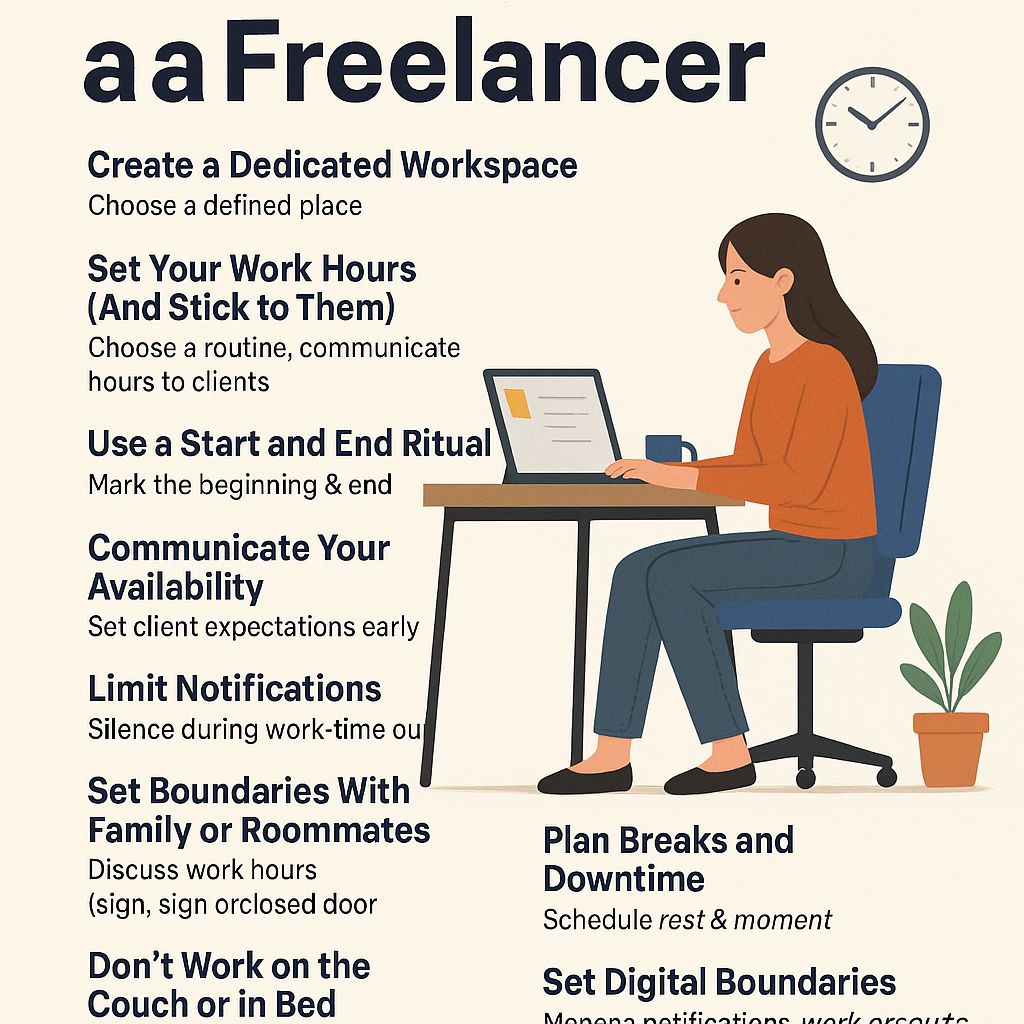Freelancing from home offers freedom—but without boundaries, that freedom can quickly become chaos. It’s easy to work too much, get distracted, or feel like you’re always “on.” That’s why learning how to set and maintain boundaries when working from home is one of the most important skills you can develop as a freelancer. In this article, you’ll learn practical strategies to protect your time, energy, and productivity.
Why Boundaries Matter for Freelancers at Home
When you work from home, the line between work and life blurs. Without clear boundaries, you may:
- Answer emails late at night
- Skip breaks and meals
- Feel guilty for resting
- Lose track of work hours
- Struggle to focus
- Burn out faster
Boundaries help you stay productive, healthy, and in control of your freelance business.
1. Create a Dedicated Workspace
You don’t need a home office—but you do need a defined place to work.
Why it helps:
✅ Trains your brain to focus
✅ Signals others that you’re working
✅ Creates physical and mental separation from “home mode”
Even a desk in the corner of a room can work—just don’t work from bed if you can avoid it.
2. Set Your Work Hours (And Stick to Them)
You don’t need a 9-to-5 schedule—but you do need a routine.
How to start:
- Choose your ideal work blocks (e.g., 9–1 and 2–5)
- Schedule breaks and meals
- Use a calendar to block time for deep work, calls, and admin
- Communicate your hours to clients
Consistency reduces decision fatigue—and increases trust.
3. Use a Start and End Ritual
Without a commute, it can be hard to mentally switch “on” and “off.” Use a ritual to mark the beginning and end of your workday.
Examples:
- Light a candle or make coffee when starting
- Review your task list
- Shut down your laptop and tidy your desk when done
- Take a walk, change clothes, or stretch
Rituals help train your mind and body to respect your work hours.
4. Communicate Your Availability
Clients don’t know your schedule unless you tell them. Set communication expectations early.
Let clients know:
- Your working hours and time zone
- Response times (e.g., “within 24 hours on business days”)
- Preferred communication channels (email, Slack, Notion)
Include this info in your onboarding emails, contract, or email signature.
5. Limit Notifications
Constant pings = constant distractions. Turn off or silence notifications during work blocks.
Tips:
- Use “Do Not Disturb” on your phone and computer
- Check email only at set times
- Mute non-essential chats during focus time
- Use tools like Focus Assist, Freedom, or Cold Turkey
Protect your focus—it’s your most valuable resource.
6. Set Boundaries With Family or Roommates
When you work from home, others might assume you’re always available. You’re not.
How to set boundaries:
- Use a sign (🟢 Available / 🔴 Do Not Disturb)
- Have a conversation about your work hours
- Wear headphones or close a door when working
- Explain that breaks are your time to socialize—not during deep work
Kind but clear communication builds mutual respect.
7. Don’t Work on the Couch or in Bed
Your body associates certain spaces with relaxation. Mixing work and rest zones can hurt both.
- Couch = distraction
- Bed = poor sleep
- Desk = focus
Train your brain to know when it’s time to work—and when it’s time to relax.
8. Plan Breaks and Downtime
Freelancers often forget to rest—especially when working from home. But rest is non-negotiable.
Schedule:
- A 5-minute break every hour (stretch, walk, hydrate)
- 30–60 minutes for lunch
- At least one full day off each week
- Evenings with no screens or work talk
Rested freelancers do better work. Period.
9. Set Digital Boundaries
Work can follow you everywhere—unless you control it.
Try:
- Having separate work and personal email accounts
- Turning off notifications after hours
- Using a second browser or profile for work
- Logging out of client platforms at the end of the day
Protect your mental space from work overload.
10. Learn to Say “No”
Freelancers often overcommit—especially when working from home, where the line between “can” and “should” gets blurry.
Say no to:
- Last-minute requests at night or on weekends
- Scope creep without compensation
- Calls outside your availability
- Personal tasks during work hours
Saying no doesn’t make you difficult—it makes you professional.
Final Thoughts: Boundaries Create Freedom
Ironically, the key to enjoying the freedom of freelancing is to create structure. Boundaries help you:
✅ Focus during work
✅ Rest during downtime
✅ Deliver better results
✅ Avoid burnout
Working from home isn’t easy—but with the right boundaries, it becomes sustainable and fulfilling.
Protect your space. Protect your time. Protect your peace.

